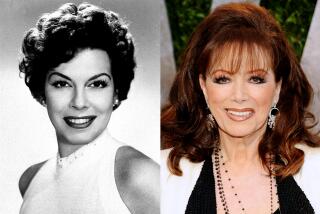BOOK REVIEW: BIOGRAPHY : A Major Look at a Minor Literary Light : THE KING OF INVENTORS: A Life of Wilkie Collins <i> by Catherine Peters</i> ; Princeton University Press, $29.95, 510 pages
- Share via
For his intricately worked plots, his swirling conspiracies, ghostly doubles, white-clad women on lonely midnight roads, furtive East Indians prepared to kill to recover a purloined moonstone, detectives who brood down wrong turns or bore holes in walls to spy on their suspects, defiant fallen women and the gleefully wicked men who trip them up--for all these things the Victorian novelist Wilkie Collins was named by one of his publishers “The King of Inventors.”
His writing was jeweled invention rather than the humane realism of his great contemporaries: Dickens’ teeming and larger-than-life worlds, George Eliot’s psychological explorations and Trollope’s social pastorale.
The French critics liked Collins because his artifice, like that of Poe, corresponded to their notion of what literature ought to be: elaborately laid-out lawns whose grass is not to be picnicked in.
The English critics were more dubious, calling him theatrical, thin and at times depraved, although they were awed by the skill and ravishment of his extravagant plotting, and by the not-quite-respectable popularity it won for him.
Trollope praised him but disapproved of the elaborate melodrama of “The Woman in White,” “The Moonstone” and “No Name,” and the way every interlocking detail was worked out in advance.
“The construction is most minute and wonderful,” wrote the man who began his own books never knowing how he was going to end them. “But I can never lose the taste of the construction.”
Dickens, who was Collins’ warmest and most powerful patron and supporter, urged him to take greater care of probabilities and suggested that a novel needed the current of life and not simply of elucidation to bear it along.
The attachment that Dickens, Eliot and Trollope felt for Collins--known to everyone including himself as Wilkie--was less for the art than for the artist.
Dickens, who helped him loyally until he became too successful to need help, found in him a gaiety, originality and loyalty that made him an ideal partner for travel and carousing. Wilkie made people smile. He was a great Victorian eccentric and he seems to have been, in his generously wrongheaded way, greatly good.
Exceedingly short, with tiny hands and feet, he had a large head with a bulge on one side, a candid smile, a collection of twitches and jerks, and an air of innocent appetite. In short, he looked like a large baby.
Women loved him dearly and he loved them back--he claimed to have conquered a married woman when he was 12--and he was, in all but the most technical sense, a sedate bigamist.
From mid-life until he died, he kept two London households with two common-law wives, each of whom he had raised from lower-class situations, and children who visited back and forth and went on holidays together. Upon his death, he divided his modest fortune between them.
It was dangerous to be a Victorian. There was the overeating--suffering acutely from gout, Collins would breakfast on eggs in black butter with pigs’ feet--the stuffy houses with bad drains, the excess of tight clothes, and a sensibility so charged up by the conflict between old religious principles and new scientific ones that the frequent result was implosion into a private anarchy.
Edward Lear’s Jumblies and toeless Pobble were not just a joke: to be a Victorian artist or intellectual was to be a kind of Pobble. Or to be the doubled personage of Stevenson’s Dr. Jekyll and Mr. Hyde, or the doubles which, as Peters notes, were a recurring theme in Wilkie’s fantasies. Toward the end of his life, with his opium habit swollen to regular tumblers of laudanum, he reported having to wrestle with his own double for possession of his writing table.
Wilkie was the son of William Collins, a diligent academic painter whose work commanded prices almost as high as those of Constable, his Hampstead neighbor. (Of two Collins’ paintings, Constable wrote that they consisted of “a coast scene with fish as usual, and a land scene like a large cow turd.”)
William was a conventional, warm-hearted father; his son, after a bout of adolescent rebelliousness, inherited the warm-heartedness but not the conventionality.
“He was as bad as he could be,” wrote Kate Dickens, Charles’ daughter and Wilkie’s sister-in-law, “yet the most gentle and kind-hearted of men.”
Peters’ biography is detailed and devoted, although her writing can be disorganized, and her summaries and analyses of the 20-odd novels are sometimes impenetrable.
Most of the novels are not only forgotten but, as is generally the case with forgotten work--by definition, in fact--forgettable. A winning portrait emerges from the detail, but it has to do a great deal of emerging.
The distinctiveness of Wilkie’s life and work could engagingly occupy an essay on the order and length of those in Virginia Woolf’s “Common Reader.” Five hundred pages smothers it.
More to Read
Sign up for our Book Club newsletter
Get the latest news, events and more from the Los Angeles Times Book Club, and help us get L.A. reading and talking.
You may occasionally receive promotional content from the Los Angeles Times.







